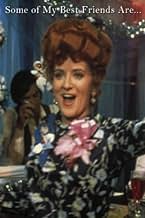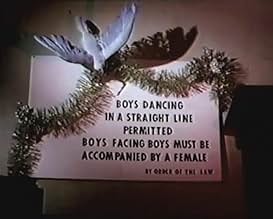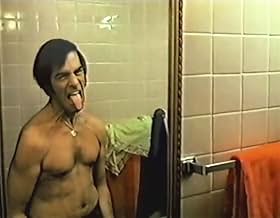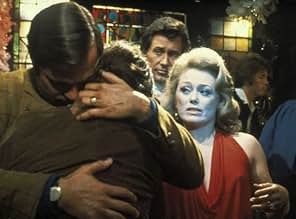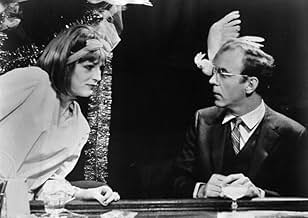Adicionar um enredo no seu idiomaA dramatic expose of the lives of a group of gays who meet in a New York City bar on Christmas Eve.A dramatic expose of the lives of a group of gays who meet in a New York City bar on Christmas Eve.A dramatic expose of the lives of a group of gays who meet in a New York City bar on Christmas Eve.
James Murdock
- Clint
- (as David Baker)
Robert Christian
- Eric
- (as Rob Christian)
Nick De Noia
- Phil Drew
- (as Nick DeNoia)
Thomas Fiorello
- Ernie
- (as Tommy Fiorello)
- Direção
- Roteiristas
- Elenco e equipe completos
- Produção, bilheteria e muito mais no IMDbPro
Avaliações em destaque
I typed the script for SOME OF MY BEST FRIENDS ARE right after grad school at UCLA for Mervyn Nelson. Moved to NY on 8/15/69 (missed WOODSTOCK at the airport) and eventually found a life in NY. When Mervyn made the film I had already been friends with Candy Darling through an incredibly interesting workshop Mervyn ran. Also in the class were Sylvia Sims, Thao Panglis (soap star) and Eric (Hank) Estrada.
I was in a fantasy scene in the film, and found the whole shooting process a great deal of fun, especially with people like Fanny Flagg and Rue McClanahan around. It opened, disappeared and was never heard of again, unless Marty Richards knows who owns it now. I think as a piece of history in gay films, this should not be forgotten. The NY Times got it right in their initial review. Sad, sad, sad.....but it laid the ground for WILL AND GRACE and BROTHERS. SO WHERE CAN I GET A COPY OF IT?
I was in a fantasy scene in the film, and found the whole shooting process a great deal of fun, especially with people like Fanny Flagg and Rue McClanahan around. It opened, disappeared and was never heard of again, unless Marty Richards knows who owns it now. I think as a piece of history in gay films, this should not be forgotten. The NY Times got it right in their initial review. Sad, sad, sad.....but it laid the ground for WILL AND GRACE and BROTHERS. SO WHERE CAN I GET A COPY OF IT?
I wish we knew more about Mervyn Nelson, the writer and director of this one... apparently he wrote a ground-breaking film on jazz around 1950, and another ground-breaking chapter of gay life back in the day. This is totally a snapshot of gay (mostly underground at the time) life in 1971. some drag, some straight-acting, some camp. and a thank you to a very young Rue McClanahan and Fannie Flagg for being a part of this. This is a good picture of people in a gay bar at various stages of acceptance; some are at peace with who they are... some are in denial, some are having conversations about being unsure of just where things are in their life. Christmas Eve, in a gay bar. Emotions. The hustler chooses a dance partner, but then has buyer's remorse. Fights. Ups, Downs. laughter. sorrow. Probably the biggest name here is Gary Sandy, much better known as the station manager in WKRP. and Gil Gerard was also Buck Rogers. It wasn't an easy time for gay folk. even the bars could be dangerous, two years after the stonewall riots in New York City. an honest look at gay life in the city, back in the day. Good stuff. an honest picture of gay life in 1971.
It's two years past Stonewall and now certainly a story like Some Of My Best Friends Are could now be put on the screen. Still it was only a very few straight
players who would cast in a gay film. You will see however a couple of adventurous souls you might recognize from the cast.
This film if anything shows Stonewall was for the young. The young gay men hanging out at the Blue Jay bar on Christmas Eve aren't content to live life as was ordained by the sexual orientation and their elders up to now. Not sure of where the direction is going, but the younger ones don't want to settle.
The older ones are scared. Not just of the dominant straight society oppression. If anything they're afraid that the young with their agitation and demonstrations will bring down unwanted attention. The older gay men in this film are deeply closeted and are afraid of the door being even slightly ajar.
The fact that back in the day the gay bars were mob controlled was certainly noted. One of the great changes in the past 50 years was first the fact that the mob ran fewer and fewer of these establishments. And then as the community developed non-alcoholic venues bars themselves began to decline. Probably a good thing because drinking establishments everywhere by their nature bring gloom after the high wears off.
Some Of My Best Friends Are is kind of an expanded version of gay life in the early 70s that Boys In The Band showed in the middle 60s. One wonders how that group of gay men would have taken to Stonewall.
This film if anything shows Stonewall was for the young. The young gay men hanging out at the Blue Jay bar on Christmas Eve aren't content to live life as was ordained by the sexual orientation and their elders up to now. Not sure of where the direction is going, but the younger ones don't want to settle.
The older ones are scared. Not just of the dominant straight society oppression. If anything they're afraid that the young with their agitation and demonstrations will bring down unwanted attention. The older gay men in this film are deeply closeted and are afraid of the door being even slightly ajar.
The fact that back in the day the gay bars were mob controlled was certainly noted. One of the great changes in the past 50 years was first the fact that the mob ran fewer and fewer of these establishments. And then as the community developed non-alcoholic venues bars themselves began to decline. Probably a good thing because drinking establishments everywhere by their nature bring gloom after the high wears off.
Some Of My Best Friends Are is kind of an expanded version of gay life in the early 70s that Boys In The Band showed in the middle 60s. One wonders how that group of gay men would have taken to Stonewall.
This story takes place on Christmas Eve in 1971 in an old-fashioned gay bar (there doesn't seem to be a "back room") in Greenwich Village.
We get a bunch of vignettes as the major players tell their stories amid the increasingly uproarious night. No gay cliche is left untold. What defeats much of the film is a murky lighting and lines that are drowned out by noise.
This is not to say that the film is a total dud. It's an important look at that pre-AIDS world and in many ways is a more honest look at gay and closeted-gay life than better known films like THE BOYS IN THE BAND or TORCH SONG TRILOGY or THE RITZ.
There are also several very good performances. In his NY Times review, Vincent Canby noted that the women come off better than the men and he's right. Rue McClanahan is good as the aging "fag hag" who cavorts with gay men as a glamorous token female in a gay world. She dresses like a drag queen and drops acid lines with the best of them. But it's also a sex-free world and therefore a safe world for her.
Sylvia Syms, not to be confused with the British actress of the same name, is excellent as the bar owner Sadie. She's sort of the over-arching mother of all the "boys" and she loves them all. At one point she poignantly tells that she never married, never had children, but she never missed out because she's always had her "boys." On the other hand, Peg Murray plays the hysterical Mrs. Nabour, who pitches a fit when she discovers her son is gay. She disowns him.
Gary Sandy plays a gay hustler who constantly boasts (it seems to be a lie) that he swings both ways, but after a bad drug trip, his self-loathing turns into a blind rage as he beats a timid cross-dresser. The cross-dresser is played by Candy Darling.
Fannie Flagg plays the cheerful hat-check girl with her hair stacked high (a la drag queen) and she even sings a number. David Drew plays a timid man who finally work up the courage to ask someone back to his apartment. Gil Gerard plays a gay man who poses as a straight guy in real life.
James Murdock (billed as David Baker) plays a drama queen who has tricked a guy (Dick O'Neill) into meeting him at the bar by posing as a woman on the phone. Then there's Carleton Carpenter as a silent older man who simply watches all the action without ever getting involved. Paul Blake plays the sarcastic Kenny.
Here and there a character utters a memorable line. One says "Facing death does not take courage. Two men facing a life together does." Another says "Everybody wants someone. Some want anybody."
As a sign of the time, there's a cop prowling around and there's a sign warning the men about dancing together. Although the film takes place after Stonewall, it's still a dangerous time.
If the film had had a central plot and central characters, this might have worked better as a film, As it is, however, it's worth a look into the dark recesses of this very dark bar.
We get a bunch of vignettes as the major players tell their stories amid the increasingly uproarious night. No gay cliche is left untold. What defeats much of the film is a murky lighting and lines that are drowned out by noise.
This is not to say that the film is a total dud. It's an important look at that pre-AIDS world and in many ways is a more honest look at gay and closeted-gay life than better known films like THE BOYS IN THE BAND or TORCH SONG TRILOGY or THE RITZ.
There are also several very good performances. In his NY Times review, Vincent Canby noted that the women come off better than the men and he's right. Rue McClanahan is good as the aging "fag hag" who cavorts with gay men as a glamorous token female in a gay world. She dresses like a drag queen and drops acid lines with the best of them. But it's also a sex-free world and therefore a safe world for her.
Sylvia Syms, not to be confused with the British actress of the same name, is excellent as the bar owner Sadie. She's sort of the over-arching mother of all the "boys" and she loves them all. At one point she poignantly tells that she never married, never had children, but she never missed out because she's always had her "boys." On the other hand, Peg Murray plays the hysterical Mrs. Nabour, who pitches a fit when she discovers her son is gay. She disowns him.
Gary Sandy plays a gay hustler who constantly boasts (it seems to be a lie) that he swings both ways, but after a bad drug trip, his self-loathing turns into a blind rage as he beats a timid cross-dresser. The cross-dresser is played by Candy Darling.
Fannie Flagg plays the cheerful hat-check girl with her hair stacked high (a la drag queen) and she even sings a number. David Drew plays a timid man who finally work up the courage to ask someone back to his apartment. Gil Gerard plays a gay man who poses as a straight guy in real life.
James Murdock (billed as David Baker) plays a drama queen who has tricked a guy (Dick O'Neill) into meeting him at the bar by posing as a woman on the phone. Then there's Carleton Carpenter as a silent older man who simply watches all the action without ever getting involved. Paul Blake plays the sarcastic Kenny.
Here and there a character utters a memorable line. One says "Facing death does not take courage. Two men facing a life together does." Another says "Everybody wants someone. Some want anybody."
As a sign of the time, there's a cop prowling around and there's a sign warning the men about dancing together. Although the film takes place after Stonewall, it's still a dangerous time.
If the film had had a central plot and central characters, this might have worked better as a film, As it is, however, it's worth a look into the dark recesses of this very dark bar.
This film now plays a lot of gay film festivals..billed as.... " The movie you love to hate"! Of course it now looks very politically incorrect. But there was a time that it really was like this. I know..I was there! P.S. It's so much fun to see so many people who went on to greater things. Michael Bluegrass
Você sabia?
- CuriosidadesThis film was way ahead of its time. One of the characters referred to J. Edgar Hoover as "....a drag queen." In 1971, Hoover was still Director of the Federal Bureau of Investigation (FBI) and viewed as a traditional American hero by the majority of his fellow Americans.
- Erros de gravaçãoWhen the hustler (Gary Sandy) rips off the drag queen's (Candy Darling) wig, her hair ribbon somehow stays attached to her real hair underneath.
- Citações
Barrett Hartman: Forgive me for not getting up. It's a bit awkward.
Lita Joyce: Don't apologize. I abhor men in a vertical position.
- ConexõesFeatured in Homo Promo (1991)
Principais escolhas
Faça login para avaliar e ver a lista de recomendações personalizadas
- How long is Some of My Best Friends Are...?Fornecido pela Alexa
Detalhes
- Data de lançamento
- País de origem
- Idiomas
- Também conhecido como
- Gay Bar
- Locações de filme
- Zodiac Bar - 835 Washington Street, Manhattan, Nova Iorque, Nova Iorque, EUA(used for Blue Jay bar)
- Empresas de produção
- Consulte mais créditos da empresa na IMDbPro
Bilheteria
- Faturamento bruto nos EUA e Canadá
- US$ 117.169
Contribua para esta página
Sugerir uma alteração ou adicionar conteúdo ausente

